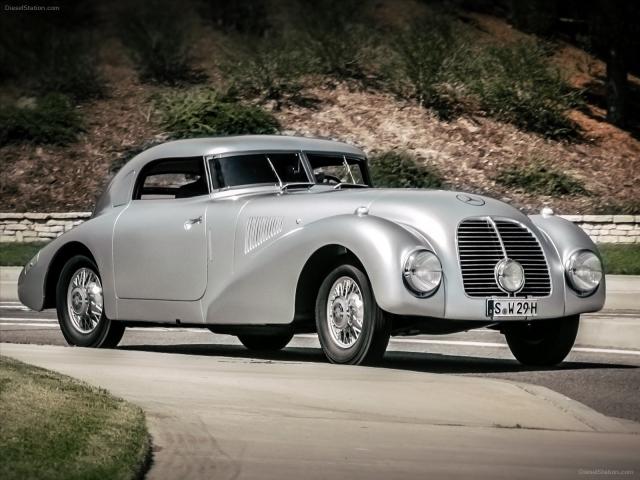1938 Mercedes-Benz 540 K Streamliner
- Brand: Mercedes-Benz
1938 Mercedes-Benz 540 K Streamliner
Launched in 1933, the sporty Mercedes-Benz 380 was intended to bridge the gap between the six cylinder engined 290 model and the massive 770 'Grosser' model. It was the first car of its type with fully independent suspension; wishbones at the front and swing axles at the rear. The new eight cylinder engine was directly derived from the 290's straight six and could be ordered Naturally Aspirated or with the familiar engageable Supercharger. In neither form did the 3.8 litre 'eight' produce enough power to move the heavy Mercedes-Benz at sportscar speeds and the 380 was not a big seller.
These problems were somewhat resolved when Mercedes-Benz replaced the 380 with the 500 K in 1934. As its name suggests, the new luxury sportscar was powered by a five litre version of the eight cylinder engine. This model came with the engageable Supercharger equipped as standard. When engaged, the maximum output was boosted from 100 bhp to 160 bhp. Mated to either a four or a five speed gearbox, the all-iron engine was installed in a steel boxed-section frame. Like its predecessor, the suspension was independent all-round and stopping power was provided by hydraulic assisted drum brakes.
Unlike many of its competitors, Mercedes-Benz actually delivered complete cars and not just rolling chassis for third parties to body. To accommodate the customers' specific wishes, the German manufacturer offered a wide variety of bodystyles that were built in their Sindelfingen based factory. The most exclusive of these was the two-seater Spezial Roadster that could easily be recognized by its V-shaped split front window. It was one of several open varieties, but there was also the choice of fixed-head coachwork of which the streamlined Autobahnkurier was the most stylish.
The 500 K was ready in time for the 1934 Berlin Motorshow and it was in the German capital that the lavish Mercedes-Benz found a fair share of customers. Many of the senior government officials used the eight cylinder during parades, but it was also very popular with the rich and famous. It still was by no means a sportscar as the 160 bhp available needed to move a car that weighed in excess of 2000 kg, regardless of the body fitted. It took nearly 20 seconds for the Teutonic beast to reach 60 mph and considering that, the top speed of 100 mph does not sound too bad.
Production of the 500 K lasted over two years and then it was replaced by the larger engined 540 K, which was first shown during the Paris Salon in the fall of 1936. Again the type number immediately gave away the car's displacement figure. The 400 cc gain was good for an additional 15 hp without and 20 hp with the Supercharger engaged. Not much changed to the line-up of open and closed body styles available, although an armoured version did become available, clearly anticipating the War. Right before WWII a second evolution was introduced with a 5.8 litre engine, but only handful of these 580 Ks were constructed.
Although the 500 K and 540 K were more popular than their predecessor only 342 and 319 respectively were constructed during the six years they were in production. Despite being very heavy to drive and rather slow, the eight cylinder cruisers are very highly regarded today. Especially in the concours d'elegance scene, where of course the show outweighs the go. Considered the quintessential 1930s production Mercedes-Benz, the 500 K and 540 K are very expensive and especially a Spezial Roadster will today easily command seven- or even eight-figure prices at auction.
Using standard 540 K chassis, Mercedes-Benz created a special streamliner in 1938 based on a design by Hermann Ahrens. The slippery duraluminium panels were mounted on an ash subframe. One of the few changes compared to a regular 540 K drivetrain was the installation of a taller final drive to allow for higher top speeds. The impetus behind developing the Streamliner was reportedly the 1939 Berlin to Rome road race, which was ultimately cancelled. Instead, the 540 K was handed to Dunlop Germany for high speed testing.
In 1940, the car was returned to Mercedes-Benz and disassembled. It was long believed to have been lost until Mercedes-Benz archivist Gerd Langer found a reference to the chassis in a list of 900 vehicles in storage. As it happens, the chassis had been preserved as had most of the drawings. It was decided to rebuild the unique Streamliner using the original chassis, a correct engine and a newly constructed body. An original panel was also found, which was a great help for the Mercedes-Benz Classic engineers. A complication were the particularly difficult to read drawings, which turned out to be a nearly lost art.
Upon completion, the 540 K Streamliner was tested in the oldest functioning wind-tunnel in Germany. The tests revealed that the car had a cd of 0.36 compared to a cd of 0.57 compared to a standard 540 K Coupe. The Streamliner made its first ever public appearance at the 2014 Pebble Beach Concours d'Elegance.
Descriptions & pictures by ultimatecarpage & deviantart & mercedes-benz & other
| Specification | |
| Production Start | 1938 |
| Country of origin | Germany |

































